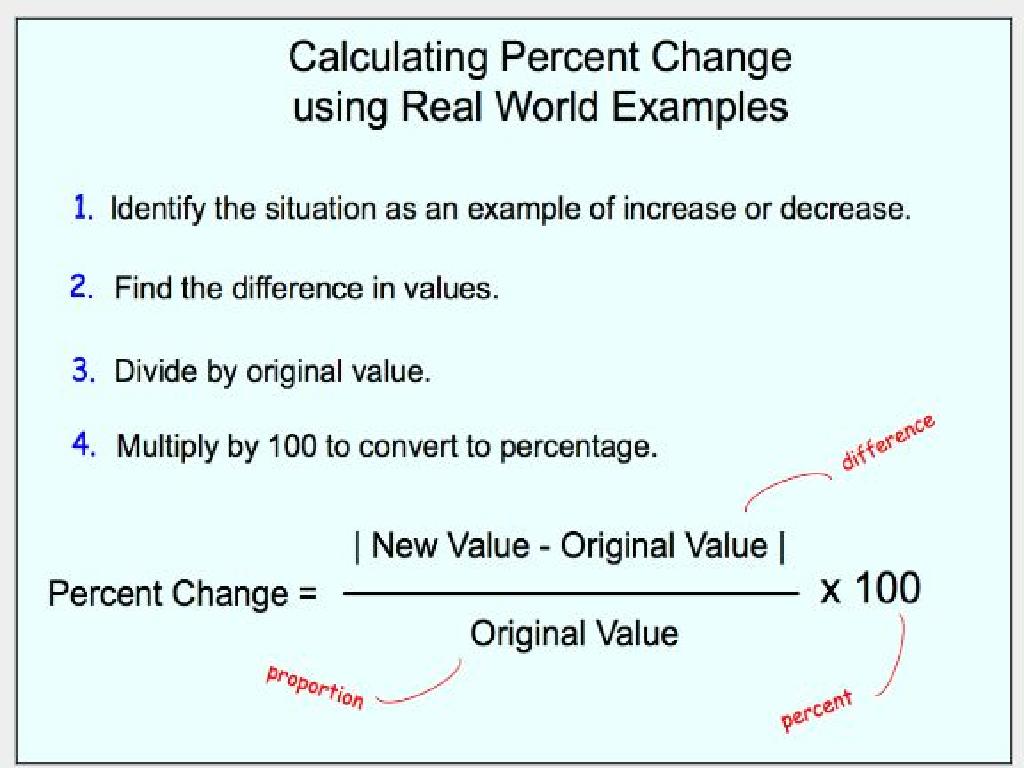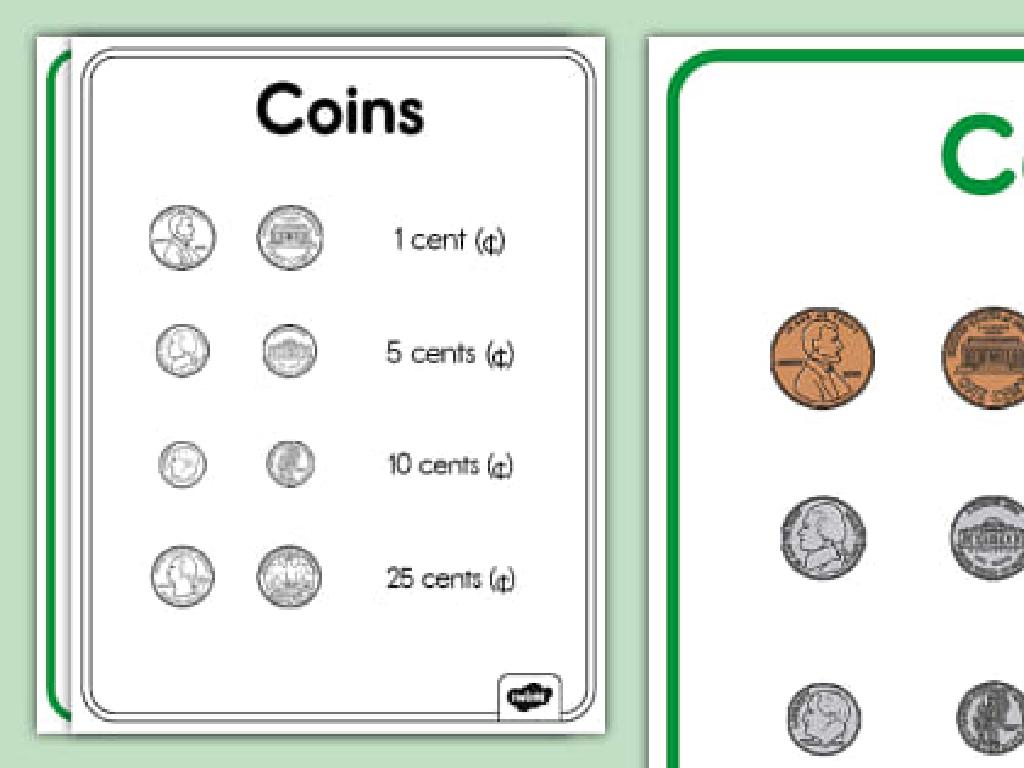Synonyms And Antonyms
Subject: Language arts
Grade: Second grade
Topic: Categories
Please LOG IN to download the presentation. Access is available to registered users only.
View More Content
Today’s Adventure: Synonyms and Antonyms!
– Exploring word relationships
– Synonyms: Words that match
– Words with the same meaning, like ‘big’ and ‘large’
– Antonyms: Words that oppose
– Words with opposite meanings, like ‘hot’ and ‘cold’
– Enhancing writing with synonyms and antonyms
|
This slide introduces the concept of synonyms and antonyms to second graders, helping them understand how words can be related by meaning. Synonyms are words that mean the same thing and can be used interchangeably to make writing more interesting and avoid repetition. Antonyms are words with opposite meanings, which can help create contrast and make descriptions clearer. Encourage students to think of synonyms and antonyms for words they already know, and explain how using these can make their stories and essays more exciting and engaging. Provide examples and plan activities where they can practice identifying and using synonyms and antonyms in sentences.
Exploring Synonyms
– Understanding synonyms
– Synonyms have similar meanings
– Words that mean the same thing
– Examples: ‘happy’ and ‘joyful’
– ‘Quick’ is similar to ‘fast’
– Class activity: Thumbs Up!
– Show thumbs up for synonym pairs
|
This slide introduces the concept of synonyms to second-grade students. Begin by explaining that synonyms are words that have the same or almost the same meaning, which helps make our writing more interesting. Provide clear examples, such as ‘happy’ and ‘joyful’, and ‘quick’ and ‘fast’, to illustrate the point. For the class activity, say a pair of words and ask students to show a thumbs up if they think the words are synonyms. This interactive activity will help reinforce their understanding of synonyms. Prepare a list of word pairs in advance for the activity, ensuring a mix of obvious and more challenging pairs to cater to different learning levels.
Let’s Find Synonyms!
– Play the Synonym Match game
– Match words with similar meanings
– Pair up for synonym discovery
– Work together with a classmate
– Find many synonym pairs
– How many pairs can you make?
– Share your findings with everyone
– Discuss the synonyms you found
|
This slide introduces a class activity focused on synonyms. The Synonym Match game is designed to be a fun and interactive way for students to learn about words with similar meanings. Students should pair up and use their language arts books or any classroom resources to find as many synonyms as possible. Encourage them to think about words they use every day and find alternatives. After the activity, each pair will share their list of synonyms with the class, fostering a collaborative learning environment. For the teacher: Prepare a list of words suitable for second graders that they can use to find synonyms. Consider creating a worksheet with two columns for students to fill in. Offer small rewards for the most creative or the longest list of synonym pairs to motivate participation.
Exploring Antonyms
– Antonyms are opposites
– ‘Hot’ vs. ‘Cold’
– Example: opposite of ‘hot’ is ‘cold’
– ‘Light’ vs. ‘Dark’
– Example: opposite of ‘light’ is ‘dark’
– Fun Antonym Activity!
– When you know the answer, wave your hand!
|
This slide introduces the concept of antonyms to second-grade students. Begin by explaining that antonyms are words with opposite meanings, such as ‘hot’ and ‘cold’. Use visual aids or gestures to help students understand the concept. For the activity, say a word out loud and have students wave their hand when they know the antonym. This interactive approach will engage the students and make the learning process enjoyable. Prepare a list of words suitable for their level and encourage participation. Praise correct answers and gently guide those who need help. This activity will help reinforce their understanding of antonyms in a fun and memorable way.
Exploring Antonyms: Opposite Frenzy
– Let’s play ‘Opposite Frenzy’
– Find worksheet opposites
– Look for words that mean the opposite
– Write down each antonym
– Use the context to guess the antonyms
– Class review of answers
– We’ll discuss and learn together
|
This slide introduces a class activity focused on understanding antonyms by playing ‘Opposite Frenzy’. Distribute worksheets with a list of words to the students and ask them to find the opposite of each word. Encourage them to think about the meaning of each word and use context clues if they’re stuck. After they have written down the antonyms, organize a class review where students can share their answers and discuss any discrepancies. This will help reinforce their understanding of antonyms. Prepare to offer guidance and clarification as needed, and consider providing examples or hints if students struggle with certain words. The goal is to make learning antonyms an interactive and enjoyable experience.
Spicing Up Stories with Synonyms and Antonyms
– Enhance stories with synonyms
– Synonyms are words that mean the same as another word, making stories more exciting!
– Rewrite with sparkling synonyms
– Turn ‘The big dog barked loudly’ into ‘The enormous hound howled thunderously.’
– Flip meaning using antonyms
– ‘The happy boy jumped’ can change to ‘The sad boy sat.’
– Practice makes perfect
|
This slide aims to teach students how the use of synonyms and antonyms can make their writing more interesting and expressive. Synonyms can add variety and depth, while antonyms can completely change the direction of a sentence. Encourage students to think of synonyms as a way to add flavor to their stories, like using ‘gigantic’ instead of ‘big’. For antonyms, they can learn how opposite words can change the meaning of a sentence, providing a contrast in their storytelling. Have students practice by taking simple sentences and rewriting them with synonyms and antonyms to see the difference. This exercise will help them understand the power of word choice in writing.
Class Activity: Synonym & Antonym Story Time
– Create a story with 3 synonyms
– Synonyms are words that mean the same
– Include 3 antonyms in your story
– Antonyms are words with opposite meanings
– Work together in small groups
– Share stories with the class
|
This activity is designed to help students understand and practice using synonyms and antonyms in a fun and creative way. Divide the class into small groups and give them time to create short stories that include at least 3 synonyms and 3 antonyms. Encourage them to use their imaginations and think about how synonyms and antonyms can change the meaning of a sentence. After the activity, have each group share their story with the class. Celebrate their efforts by acknowledging their ‘word wizardry’. This will not only reinforce their understanding of the concepts but also improve their teamwork and storytelling skills. Possible variations of the activity could include drawing illustrations for their stories, acting them out, or creating a class book with all the stories.
Synonyms and Antonyms: Review & Homework
– Recap on synonyms and antonyms
– Synonyms are words that mean the same, antonyms are opposites
– Using them in our writing
– They make our stories more interesting and precise
– Homework: Find 5 synonym & antonym pairs
– Look in your favorite book for words that mean the same or opposite
– Share your findings next class
– Be ready to tell us about the words you find!
|
Today’s lesson focused on understanding synonyms and antonyms, which are crucial for enriching vocabulary and making writing more vivid and accurate. Encourage students to reflect on how these can improve their storytelling or descriptions in their writing. For homework, students should find examples in the context of a book they enjoy, which will help them better grasp the concept. In the next class, create an interactive session where students can share their findings and discuss how the context provided clues about the meanings of the words.






